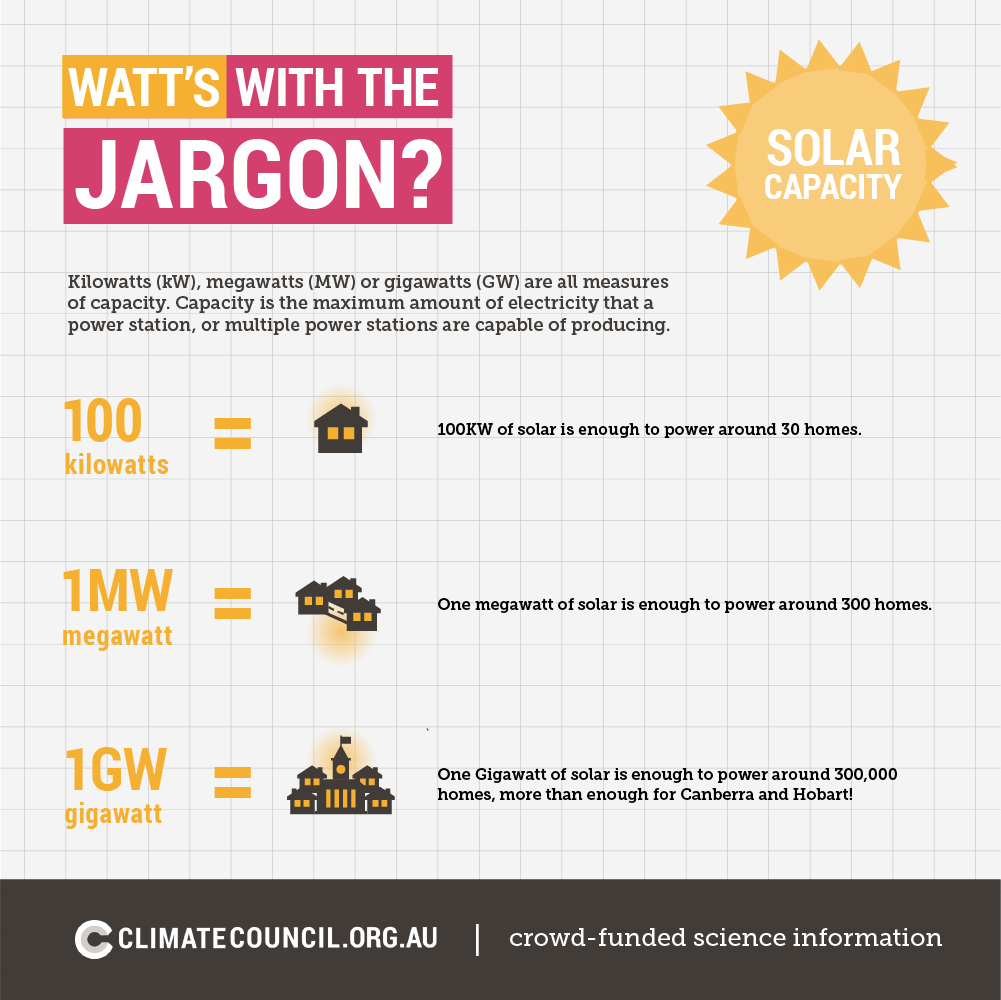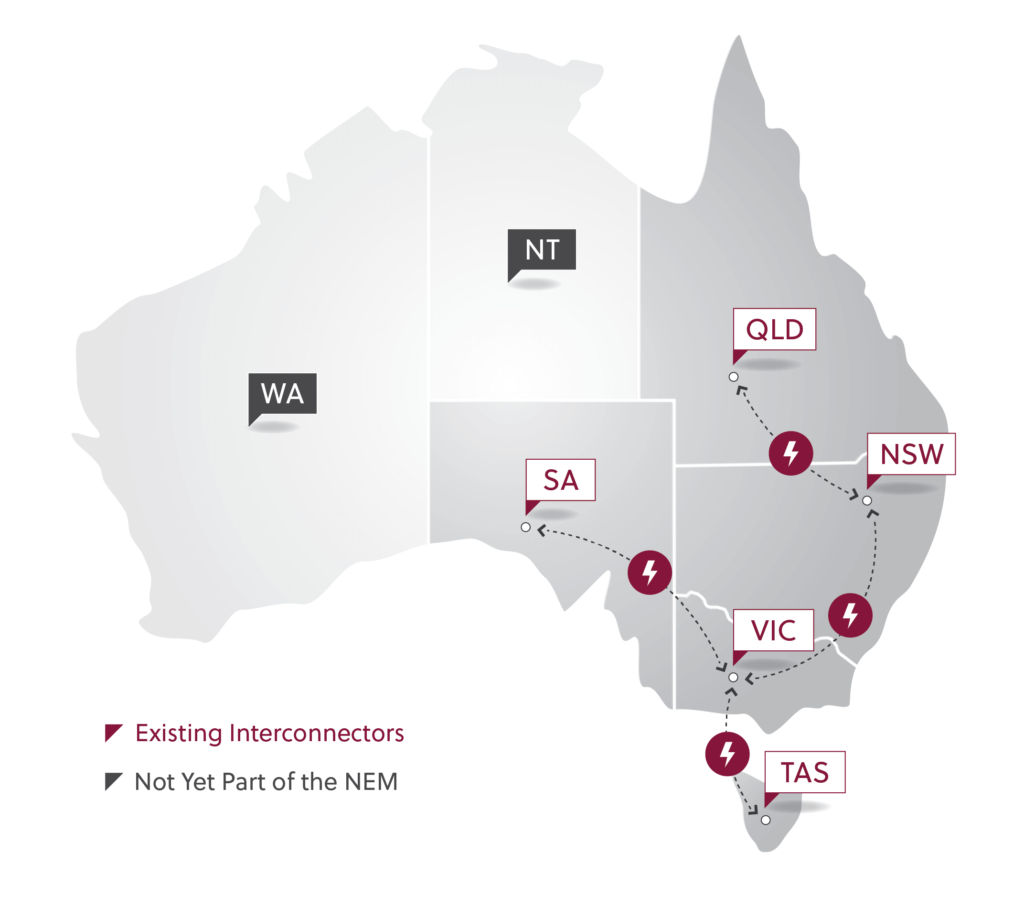Energy buzzwords
Inertia. Synchronous generator. Dispatchable power. Frequency response. Get to know your energy buzzwords with our useful guide, which will help you talk about the complexities of the energy debate, including the role of renewable energy and storage in Australia’s energy mix, with ease. Collated by the Climate Council’s own energy experts.
Energy is defined as the ability to do work, such as moving against a force like gravity. For this website, the term “energy” includes the power that comes through the electricity grids, but also includes energy produced in order ways, such as the heat required for hot water (whether solar or gas-powered), the power used in cars, trucks and buses, and the power used off-grid, such as in diesel generators.
Electricity is a form of energy which is able to be transferred by transmission lines to power things such as businesses, households and devices. Once generated by electricity producers, it is distributed through a network of high-voltage transmission lines which zig-zag the country, feeding into step-down transformers before arriving into regional grids.
The electricity network delivering power to our homes is one of the most complex systems that we will ever encounter, but very few of us ever turn our minds to it.
Electricity demand is the total amount of power needed to supply all electricity needs at a certain time.
Electricity demand changes based on:
- The time of day: electricity use spikes through the day as people move between their homes and workplaces.
- The weather: we need more electricity at times when it is very hot or very cold to keep our buildings comfortable.
- The day of the week: usage is normally higher on weekdays than weekends.
- Long term economic trends, decreasing at times of recession and decreased production.
- The needs of very large electricity users, like aluminium smelters.
Renewable electricity is electricity produced by natural sources of energy, such as energy that comes from the sun, wind and waves. These are renewable forms of energy because they cannot be depleted and will not eventually run out. This gives them a strong advantage over fossil fuels and nuclear sources of energy that are non-renewable, contribute to climate change and will ultimately be exhausted.
Wind, solar and hydro-electricity are among the most common types of renewable energy which we convert to electricity to power our societies. To meet the challenge of climate change, we must immediately move all energy needs to renewable sources. This means ending all consumption of coal, oil and gas.
Fossil electricity is electricity produced by burning fossil fuels, including coal, oil and gas. Through this process of burning, large amounts of carbon dioxide and other pollutants such as sulphur dioxide, lead, mercury, nitrogen oxides and other various heavy metals are released into the atmosphere. These pollutants not only directly affect our health through air quality, but also disrupt our climate, making weather extremes such as drought, flood, fire and heatwave more frequent and more ferocious.
Fossil forms of energy are also non-renewable, meaning they are depletable and will ultimately run out. But more importantly, we must end the use of fossil fuels as soon as possible to manage with the growing threat of climate change.
After decades of warnings from the scientific community, the Australian Federal Government is lagging behind most of the world in its progress toward ending its fossil fuel obsession. This is despite the fact that it is the most vulnerable country in the world to climate change’s effects and the fact that it is blessed by being the sunniest and windiest inhabited continent on the planet.
Coal is formed underground in a process lasting many millions of years. Over this long period, the remains of plants and other organic materials, which got their energy from the sun, are buried beneath the earth's surface. Trapped under immense pressure and heat, this vast build up of energy is slowly compressed to form coal.
Coal fired power stations use this ancient form of photosynthesised energy by burning coal to create heat, which is then used to boil water. This produces steam that spins a turbine to create electricity. The process, however, is extremely polluting.
Burning coal releases not only carbon dioxide, a heat-trapping greenhouse gas that is driving climate change, but many other damaging airborne pollutants. These include mercury, lead, sulphur dioxide, nitrogen oxides, soot and various other heavy metals. All of these pollutants directly affect our health, causing short and long term illness and death.
Black coal is a type of coal that is exposed to intense pressure and heat under the earth's surface for 100-300 million years.
Containing between 45-86% carbon, it is denser, harder and has a higher energy content than brown coal, holding less moisture and ash. It is the most used form of coal in Australia and Australia’s exports of black coal to other countries is driving climate change across the world.
Brown coal is formed over approximately 100 million years. Because of this, it is softer, containing less carbon, more ash and moisture than black coal.
While brown coal is used less in Australia it is far more polluting than black coal. Much more must be burnt to produce the same amount of electricity. Victoria’s three largest power stations--Loy Yang A, Loy Yang B and Yallourn--all consume brown coal. The annual greenhouse gas emissions of these three stations is higher each year than the emissions of Sri Lanka, a country with more than 20 million people. This extreme inefficiency is one reason why brown coal is rarely, if ever, exported.
Metallurgical coal, also referred to as coking coal, is one of the hardest, carbon rich types of coal. Due to its high carbon content, it is primarily used in steel and iron production. As a result, its price is strongly pegged to the demand of steel and iron products.
Recent advances in technology have led to pilot projects by mostly European companies replacing the use of polluting coal with renewable powered hydrogen, producing what's known as “green steel”.
When successful, this will transform one of the most polluting industries in the world.
Emissions from electricity generation, energy use or other sources are an avoidable polluting by-product of most societies. While there are many different greenhouse gases, carbon dioxide is the most important of all. While different greenhouse gases work in different ways, climate experts often measure them together using a single unit: tonnes of carbon dioxide equivalent greenhouse gas emissions, or “tCO2-e”.
In electricity, the amount of greenhouse gas released depends on the emissions intensity of the power station. The most important aspect of emissions intensity is the fuel source used. Fossil fueled electricity, such as that produced in Australia’s ageing coal fleet, is one of the most polluting forms of electricity generation. Renewable electricity sources like solar and wind are among the least polluting.
The emissions intensity of a power station refers to the volume of greenhouse gas emitted per unit of electricity. Replacing old fossil fueled power stations with more efficient and renewable electricity sources reduces the emissions intensity of the grid overall leading to healthier communities and a more stable climate.
Fugitive emissions are a type of greenhouse gas emissions. Fugitive emissions occur during the production, processing and transport, storage, transmission and distribution of fossil fuels, such as coal, oil and gas.
Throughout these activities vast quantities of greenhouse gas are intentionally released into the atmosphere as part of normal operations. While gases can also escape through accidental leaks in pressurised equipment, these accidental leaks are a far smaller source of greenhouse gas than those releases that occur by design.
The intentional release of greenhouse gases occurs at every stage of the exploration, production, transport and consumption of coal, oil and gas, but is especially important in the production of gas, where under certain circumstances, the supposed benefit of gas over coal can be entirely eliminated if fugitive emissions, intentional releases, accidental leaks and landscape releases (‘migratory emissions’) are considered in full.
All electricity grids need to balance electricity demand and supply, and cope with variability (to respond to demand changes during the day, week, and seasons). Power stations, like coal and nuclear (sometimes referred to as "baseload"), run continuously, producing a constant output of electricity. These power stations are very inflexible, and slow to respond to changes in electricity demand. These power stations are poorly suited to the needs of a modern, more flexible electricity grid.
In a modern electricity grid, electricity demand and supply can be balanced through a mix of variable renewables (wind and solar PV), on-demand renewables (such as solar thermal, biomass or established hydro), energy storage (such as pumped hydro or batteries), energy efficiency and demand response.
Storage allows energy to be stored for future use making it possible to manage differences between the time when energy is created and the time when it is needed. Batteries and pumped hydro are both examples of methods to store electricity. Without these storage options, our society would have to rely on highly-polluting “peaker” plants, such as those powered by gas.
These technologies change the relationship between generation and use of energy sources, allowing us to capture solar energy from the sun to use when it is no longer shining. For example, excess solar electricity produced by a solar panel under the sunlight of the day, can be stored in a battery and used throughout the night, removing the ‘use it or lose it’ inflexibilities of the past.
Due to increases in production and widespread use of batteries in cars, garages and offices, the price of storage has collapsed over the last decade. In 2019, batteries were one tenth of the price that they were in 2010, and they still have further to fall. This is making household and grid-scale storage a key plank of the zero emissions future.
For more detail please see:
Smart grids modernise the process of delivering electricity from generators to end users, through the integration of new technologies. These enable the collecting and sharing of new information, rapid responses to the operating environment as well as remote management of technology to stabilise the grid in high demand periods.
A smart grid can enable the best use of the grid to lower prices, ensure reliability, and reduce greenhouse gas emissions. One of the most exciting uses of smart technologies on the grid is their potential to maximise the benefit provided by rooftop solar with household batteries by ensuring that homeowners can sell their power when prices are high, and buy it when prices are low.
A virtual power plant is a decentralised, or community based, network of power generation, storage and flexible consumers working together to meet their energy needs.
Solar panels and batteries are often individually owned, but under a virtual power plant they are controlled centrally and collaboratively so that everyone, the owners, grid operators and the rest of the community can receive the maximum benefit. Virtual power plant platforms allow excess energy to be sold or stored between members, reducing electricity costs for everyone involved and relieving pressure off the grid.
When a region loses power due to a major power supply disruption, affecting a significant number of customers (a widespread blackout).
Measured in kW or MW, capacity is a measure of the maximum amount of power able to be generated by a given power generation plant.

Demand response management involves reducing consumer demand for energy by paying consumers to reduce their usage. Demand response management is useful for responding to short periods of very high electricity consumption to avoid electricity shortages.
Dispatchable power refers to power stations (and other technologies) which are able to be turned on and off, or ramped up and down quickly to balance electricity supply and demand.
There is a wide range of technologies capable of providing dispatchable power including pumped hydro, solar thermal, batteries, certain types of gas power stations as well as demand response management.
Frequency is a measure that enables operators to know if electricity supply and demand is in balance. Frequency response is a service which can be provided to re-balance electricity supply and demand. This service can be provided by a range of technologies including battery storage systems, and modern wind turbine and solar technology.
Generators convert one form of energy into another. Solar plants convert solar radiation from the sun into electricity while fossil fuel power stations burn coal and gas to convert it into electricity.
An energy company that both generates and sells electricity.
Any voltage higher than 1 kilovolt.
Inertia provides an initial, immediate response to keep the electricity system working when supply and demand are out of balance.
Power stations that generate electricity via large rotating steam or water turbines are sometimes called synchronous generators. These rotating steam and water turbines provide what is known as ‘physical inertia’.
Solar thermal, hydropower, and biomass power plants are synchronous generators capable of providing physical inertia. Renewable power plants (like wind and solar PV) and battery systems can be configured with appropriate software controls to provide similar grid stability services to physical inertia.
A high voltage transmission line, or group of power lines connecting different regions. Interconnectors transport electricity very long distances, connecting up the electricity grids of Australia’s eastern states. Interconnectors can increase the flexibility of the grid.
Demand for electricity by an individual, business or broader region.
Load shedding is when users of power are deliberately disconnected from the power system, or the amount of electricity they can use is reduced for a short period of time. This is usually experienced as localised, short-term power interruptions. Load shedding is designed to protect the overall electricity system when there is not enough power supply to meet demand.
The National Electricity Market, NEM, is not actually a “national” grid. The NEM refers to the interconnected power grids and operating systems connecting the eastern states of Australia (Queensland, New South Wales, Victoria and Tasmania) as well as South Australia and the Australian Capital Territory.
The Northern Territory and Western Australia are not part of the NEM. There are two separate interconnected systems in Western Australia (the South West Interconnected System (SWIS) and the North West Interconnected System (NWIS)) and 35 other smaller grids. The Northern Territory has three smaller separate electricity systems.

Image source: ElectraNet
The National Electricity Objective (NEO) guides the operation of the NEM. The current NEO aims to: to promote efficient investment in, and efficient operation and use of, electricity services for the long term interests of consumers of electricity with respect to – price, quality, safety, reliability, and security of supply of electricity; and the reliability, safety and security of the national electricity system.
Operating reserve is planned spare electricity generation capacity that can be called upon when there are unexpected variations in electricity demand, or generation or transmission faults.
Reclassification ensures that the electricity system is operated more carefully during periods where extremes are likely to occur, such as severe weather conditions, lightning storms and bushfires.
The price for electricity within a given time period, usually a 30 minute period.
Power plants, which generate electricity via large rotating steam or water turbines, are sometimes called synchronous generators. Coal and gas power stations are synchronous generators, but so too are solar thermal, hydropower, and biomass power plants.
